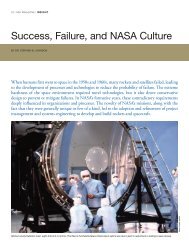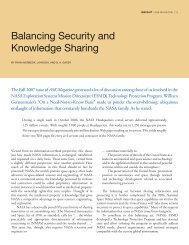An Introduction to System Safety - NASA ASK Magazine
An Introduction to System Safety - NASA ASK Magazine
An Introduction to System Safety - NASA ASK Magazine
Create successful ePaper yourself
Turn your PDF publications into a flip-book with our unique Google optimized e-Paper software.
24 | <strong>ASK</strong> MAGAZINE<br />
Seated at the witness table before the Senate Committee on Aeronautical and Space Services hearing on the Apollo 1 accident are (left <strong>to</strong> right) Dr. Robert C.<br />
Seamans, <strong>NASA</strong> deputy administra<strong>to</strong>r; James E. Webb, <strong>NASA</strong> administra<strong>to</strong>r; Dr. George E. Mueller, associate administra<strong>to</strong>r for Manned Space Flight; and Maj. Gen.<br />
Samuel C. Phillips, Apollo Program direc<strong>to</strong>r. In an effort <strong>to</strong> prevent another such tragedy from occurring, <strong>NASA</strong> commissioned the General Electric Company<br />
and others <strong>to</strong> develop policies and procedures that became models for civilian space flight safety activities.<br />
hazards, subjective judgments about the likelihood of a<br />
hazard are usually adequate and all that is possible when<br />
design decisions must be made. In addition, probabilistic<br />
risk analyses that exclude potential causes of an accident,<br />
including interactions among non-failing components,<br />
design errors, software and hardware requirements errors, and<br />
poor management decision making, can lead <strong>to</strong> dangerous<br />
complacency and focusing engineering efforts only on the<br />
accident causes for which those measures are possible. If<br />
enough were known about fac<strong>to</strong>rs such as design errors <strong>to</strong><br />
define a probability for them, then safety would be more<br />
effectively enhanced by removing the design error than by<br />
measuring it in order <strong>to</strong> convince someone that it will never<br />
cause an accident. In the case of the Mars Polar Lander, if the<br />
scenario that unfolded had been known and could have been<br />
included in a probabilistic risk analysis, then the engineers<br />
would have had enough information <strong>to</strong> change the software<br />
so the unsafe control command would not be issued.<br />
• <strong>System</strong> safety is more than just systems engineering<br />
and must incorporate management and safety culture<br />
concerns. <strong>System</strong> safety engineering is an important<br />
part of system safety, but the concerns of system safety<br />
extend beyond the traditional boundaries of engineering.<br />
In 1968, Jerome Lederer, then the direc<strong>to</strong>r of the <strong>NASA</strong><br />
Manned Flight <strong>Safety</strong> Program for Apollo, wrote:<br />
<strong>System</strong> safety covers the <strong>to</strong>tal spectrum of risk<br />
management. It goes beyond the hardware and associated<br />
procedures of system safety engineering. It involves:<br />
attitudes and motivation of designers and production<br />
people, employee/management rapport, the relation<br />
of industrial associations among themselves and with<br />
government, human fac<strong>to</strong>rs in supervision and quality<br />
control, documentation on the interfaces of industrial<br />
and public safety with design and operations, the interest<br />
and attitudes of <strong>to</strong>p management, the effects of the<br />
legal system on accident investigations and exchange of<br />
information, the certification of critical workers, political<br />
considerations, resources, public sentiment, and many<br />
other nontechnical but vital influences on the attainment<br />
of an acceptable level of risk control. These nontechnical<br />
aspects of system safety cannot be ignored.<br />
Using these general principles, system safety attempts <strong>to</strong><br />
manage hazards through analysis, design, and management<br />
procedures. Key activities include analyzing system hazards from<br />
the <strong>to</strong>p down, starting in the early concept design stage <strong>to</strong> eliminate<br />
or control hazards and continuing during the life of the system <strong>to</strong><br />
evaluate changes in the system or the environment; documenting<br />
and tracking hazards and their resolutions (establishing audit trails);<br />
designing <strong>to</strong> eliminate or control hazards and minimize damage;<br />
maintaining safety information systems and documentation; and<br />
establishing reporting and information channels. ●<br />
For more information see the following:<br />
• http://sunnyday.mit.edu/papers/jsr.pdf<br />
• http://sunnyday.mit.edu/accidents/safetyscience-single.pdf<br />
• http://sunnyday.mit.edu/ESMD-Final-Report.pdf<br />
nancy Leveson is a professor of aeronautics and<br />
astronautics at Massachusetts Institute of Technology. She has<br />
been associated with <strong>NASA</strong> for more than twenty years, was a<br />
member of the <strong>NASA</strong> Aerospace <strong>Safety</strong> Advisory Panel at the<br />
time of the Columbia loss, and was a consultant for the Columbia<br />
Accident Investigation Board. She is a member of the National<br />
Academy of Engineering.<br />
Pho<strong>to</strong> Credit: <strong>NASA</strong>




